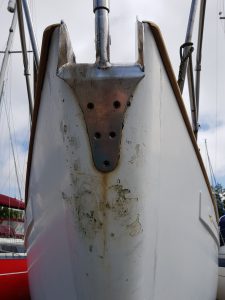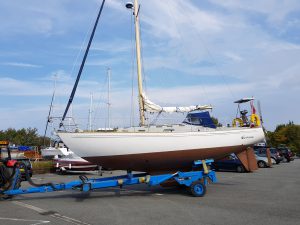A 38ft steel cutter with a purpose-built workshop and a watermaker – and a solid fuel stove… and some means of getting the dinghy out of the way…
We’ve all got the ideal boat. I found mine while going to a family wedding in Australia. The owner had done much of the fit-out himself – and all with loving care. You could see how much of his soul went into this – after all it was his big project … his retirement in the sun.
The trouble was, by the time he finished it, he was too old. His health had taken a turn for the worse and she was up for sale for a fraction of what he’d spent on her.
She was too much for me – both in terms of expense and the sheer weight of the gear. But she did provide a vital lesson: You’re never going to be completely ready. As long as the boat is properly seaworthy, it is more important to get on your way than to have somewhere dry to put the loo paper.
It was this thought that pushed me out of Conwy marina yesterday. In fact it was the same thought that pushed me out the day before. After nearly three months, Samsara went into the water. This was the third booking I had made for the hoist. The first was wildly over-optimistic so we won’t think about that one. The second was after the man with the electric polisher I had hired to smarten up the hull announced: “Hang on. This has been painted.”
And it had too. Nobody had noticed – even the surveyor hadn’t noticed. Of course, once a hull has been pointed, it has to go on being painted. I spent a depressing 24 hours looking up the cost of a respray and then went out and bought a paintbrush. I must say, I’m very pleased with the result: If you don’t get too close, you’d never know the difference.
But of course, that meant the four coats needed a week to harden before she could go in the slings.
So when we reached the third attempt and Dave Worthington, the engineer, came down to oversee his skin fittings getting wet for the first time, we started the engine. The engine was one of the many items excluded from the survey.
It took several attempts at starting. Dave bled the fuel. He listened, head cocked on one side, clearly not happy. Although it ran, it didn’t seem to pick up properly – as if the cylinders were having trouble working out who was going to go first, like a rugby club making for the saloon bar.
“It’ll probably sort itself out when it’s run a bit.” said Dave. “Might not have been started for a couple of years.”
And that was how I found myself half-way through the tortuous passage over Conwy Bar with no engine and no wind. Fortunately, there was no tide either.
I called up the Marina. Did they have a workboat handy to come and rescue me?
Conwy Marina did not offer any service outside the confines of their property (insurance). I was advised to call the coastguard on Channel 67.
Well, I was not calling the coastguard. Do that and they send a lifeboat for you. Instead I stood on the foredeck with a coil or rope in my hand and waited for a passing yacht. They took me to the marina entrance where a workboat ventured just outside (as the man said: “If they discipline me, I’ll resign.”)
And the next morning Dave returned and discovered that the electric “off” switch was sticking. I could have spent a day bleeding the system without discovering that.

The Old Man




I like the way you write. It flows nicely and I get to feel the essential feel of the sea. Thankyou.